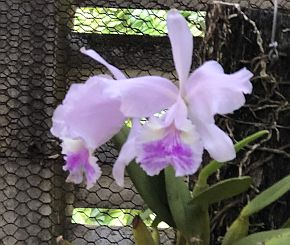
(in progress)
Cuba: Orchid of the Caribbean
A Pictoral Diary
Introduction: Traveling to Cuba on what was called a “Religious Activities Trip”, I thought I was free of the stereotypes, like communists or totalitarian state of the USA propaganda toward Cuba. But I was not free of these prejudices as these observations will reveal. Upon returning I sought more information on History of Cuba and of Fidel Castro and was happy to read that one of my elders, Dorothy Day, co-founder of the Catholic Worker movement, was fascinated by her experience of the Cuban revolution. If she was alive I would be happy to report that all the great things she observed in Cuba in 1961, the right of education and healthcare for all, the stress on equality of all persons and provisions for food and housing for all citizens have flourished. The revolution lives on in the people. Here are some of my observations:
Friday, Dec. 1
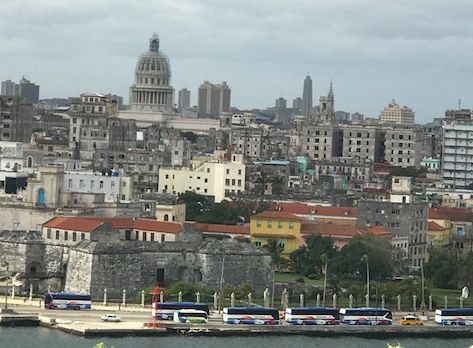
Havana
Orientation
We stayed at Casa Sacerdotal, a Catholic retreat place in Havana. Upon arriving we were given a basic orientation of what we would observe: free education for all; the right to health care; a monthly ration card to all residents for basics food and drink; affordable housing with high home ownership; a society dedicated to equality for all. It seemed a little too good to be true but our Cuban guide was sincere. There was also a chance to exchange dollars for CUC’s, a form of Cuban money compatible with the international market. The common currency in Cuba was the Peso, about 25 to one CUC.
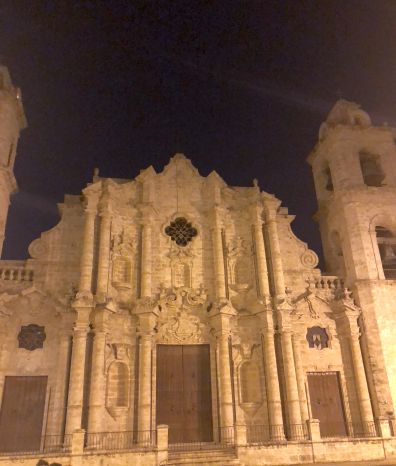
Our first visit was to the Cuban Council of Churches, our sponsor for what was designated as a “religious activities trip”. All faiths and churches, except Roman Catholic, are members. We were delighted and surprised to hear of the various activities of the denominational and non-denomination churches working together. Churches are thriving in Cuba and involved in all kinds of ministry and social outreach. There is no conflict between Churches and State in Cuba and true freedom and separation of Church and State, not freedom from religion. Our first meal was there. Meals were quality, not quantity with lots of fresh vegetables and fruits every meal. Sauces were wonderful. Soup is healthy and delicious. Fresh food. No frozen.
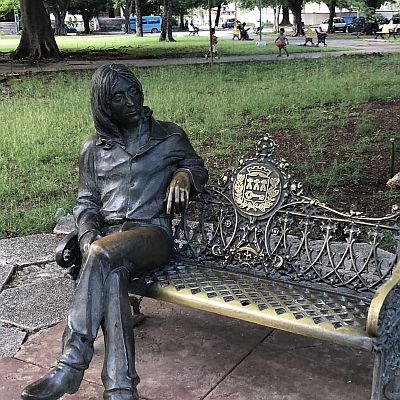
Saturday, Dec. 2
On the way to the market, we stopped at a park, dedicated to Beatles John Lennon, who is highly respected in Cuba. It seems his music of freedom and equality runs true for Cubans.
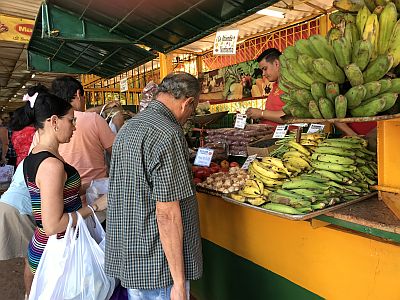
Our first visit was to a neighborhood agro-market, like our farmer’s markets. At first, prices seem high but we were reminded that prices were in pesos. There were all kinds of fresh food in the market, vegetables, fruits, meats, honey and more. The prices were low by our standards but fair according to Cuban standards. Next to the market was a market where you could redeem a ration card for the basic foods. The ration card price changes year to year but presently was worth about $45 a month in US money.
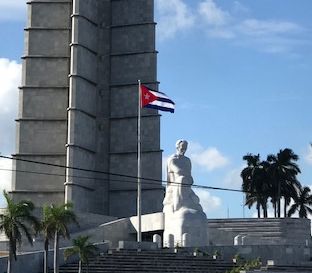
Jose Marti, Father of Cuba
From there we went to Revolution Square where major rallies are held. On the side of two tall building are major art pieces to Che Guevara and Camilo Cienfuegos, revolutionary heroes. Across the street is a statue of Jose Marti, a literary figure, poet, revolutionary and freedom fighter considered the father figure of modern Cuba. He was born in Cuba in 1853 but at a young age was exiled to Spain for his pro-independence activities. He returned to Cuba for a year in 1878 before fleeing to the exiled Cuban community in New York. He was a leader in independence from Spain but also from the US. He returned to Cuba in 1895 only to die about a month later in a small battle near Bayamo
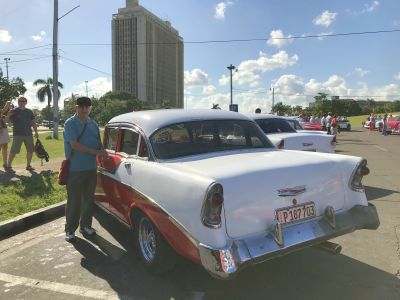
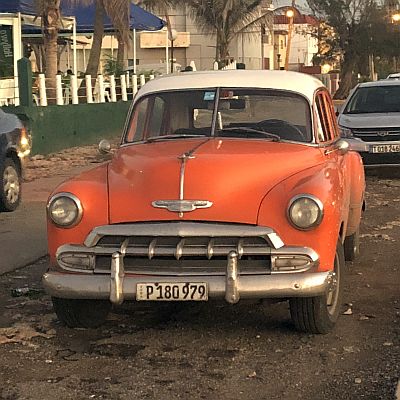
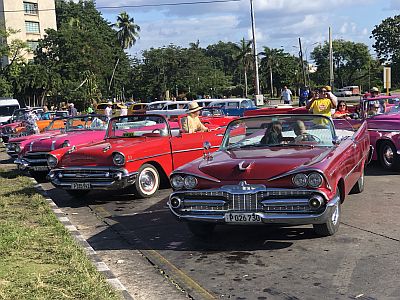
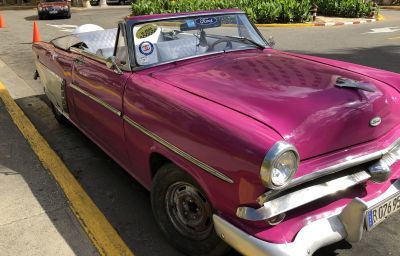
The parking lot next to the square if full of Classic American cars, ranging from Oldsmobile to Chevrolet, Buick to Ford with a nice sampling of Chrysler’s old Plymouth brand. After the Cuban revolution in 1959 due to politics it became difficult to purchase new American cars and or even parts for them. As a result, not only do Cuban citizens drive vehicles straight out of the 1950s, but these vehicles are kept running through a hodgepodge of hand-built, improvised parts. The Classic Cars are seen everywhere in Cuba and are a sign of Cuban ingenuity, that can be seen everywhere in the country. The classic cars in this parking lot offer tourist rides around Havana.
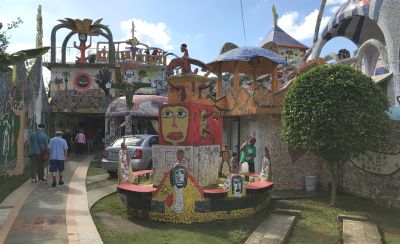
We visited the neighborhood in Jaimantes, outside of Havana, that contains the artistic projects of Fuster. Fusterlandia is the studio, residence and wild kingdom of José Rodriguez Fuster. Geographically we were in Jaimanitas, at the northwestern edge of the Cuban capital, but Jaimanitas has changed a lot since Fuster (as everyone here calls him) got to town 30 years ago and set about remaking the neighborhood in his own artistic image. Fuster is a painter and sculptor who came to the neighborhood of Jaimanitas and transferred his residence and area in a wonderland of art. It is something you need to experience to appreciate. Here are some pictures that may tell the story of Fusterlandia better. It has drawn a community of artist with over 80 neighbors allowing their homes to be transferred into art.
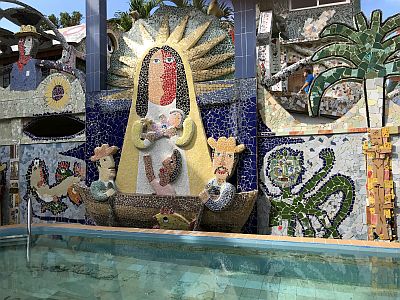
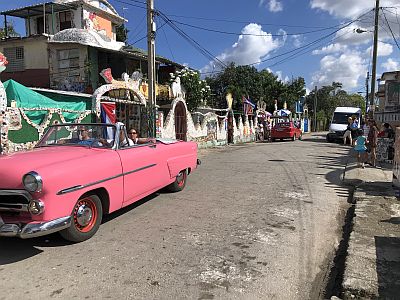
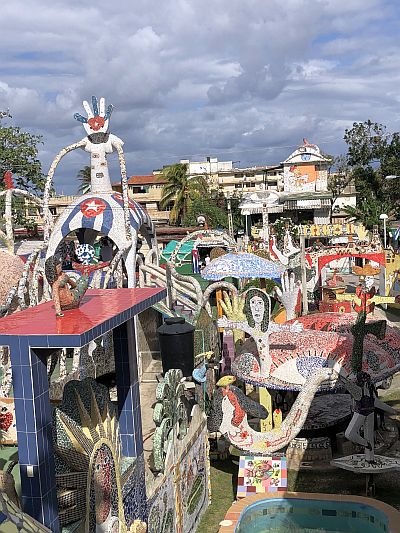
After lunch, at the Council of Churches, we had a presentation on racial issues and Afro-Cuban religions. The professor traced the history of the three main Afro Cuban religions, with the main one being Santeria. Santeria is an Afro-American religion of Caribbean origin that developed in the Spanish Empire among West African descendants. Santeria is influenced by and syncretized with Roman Catholicism. Although Cuba is a racially integrated society people are aware of their cultural roots. The professor’s son was her translator.
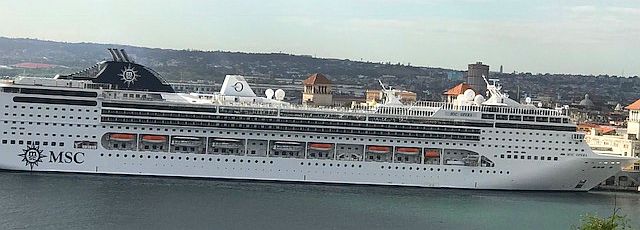
On the way to the market in Old Havana, we saw a massive cruise ship parked in the Harbor. This is a sign of how Cuba is growing in tourism. This year, Cuba was named “Safest Country for Tourism” at the 38th annual International Tourism Fair (FITUR), in Madrid, Spain
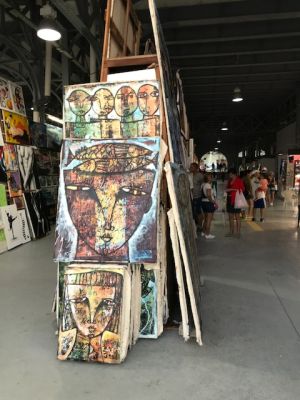
The Old Havana “San Jose” handicraft market in the harbor is a massive old warehouse full of handicraft shops. Although many have similar items this is the place to shop for handmade shirts, souvenir hats, artwork, carved kitchen utensils and so much more. With Father Bob, a member of our group, who used a cane to walk and one of the translators we made the rounds. Handcraft co-ops and families designated a member to be the seller of their goods while the others made the items. We purchased a handmade
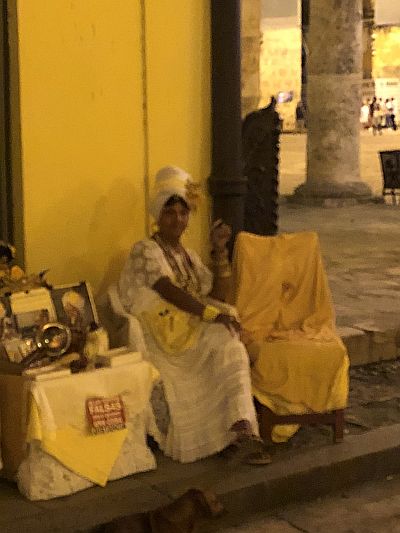
shirt from a young woman who claimed her mother made it. We purchased some original artwork from a young man who was selling it for his brother. After buying things for family and friends we took a break overlooking the harbor. Sunset was approaching and it was a serene scene.
We went to a restaurant in a square in Old Havana passing an old established Catholic Church and a lady selling her homemade items.
Sunday, Dec. 3rd
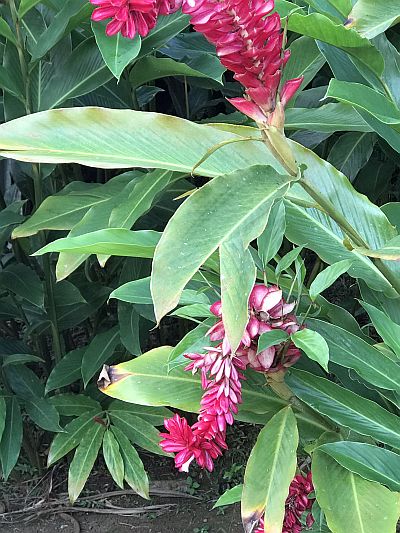
After breakfast, we departed in our van to an Orchid Garden in Soroa, Prinar del Rio. An individual Spaniard had started the garden before the Revolution and kept it going and growing it afterward and left into to government when he died. The garden on the hillside was breathtaking in its beauty with orchids, trees, and flowers everywhere. We had a guide take us through the park explaining the different types of plants and trees. Going through this wonderland of beauty the thought occurred to me that Cuba was like an orchid. Like an orchid, it was growing out of a tree, the tree of life. Like an orchid it was sustainable, thriving off of basics human rights for food, health, housing and education. Like an orchid it was renewable, constantly struggling to keep the spirit of revolution alive. Both are symbols of hope and beauty.
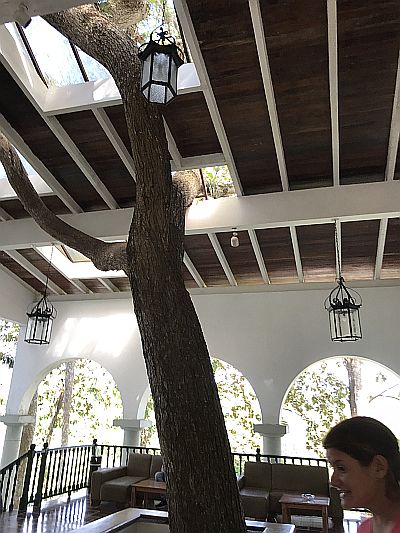
From the garden, we traveled to “Las Terrazas” a sustainable community in the countryside. This community of people of all ages grows its own food and raises animals for food. They sell products to the neighboring communities, have their own school and even their own tourist hotel. Everything is built in harmony with the environment. Instead of removing trees from the hotel they built it around the trees with the roof open in spots so the tree can grow and flourish.
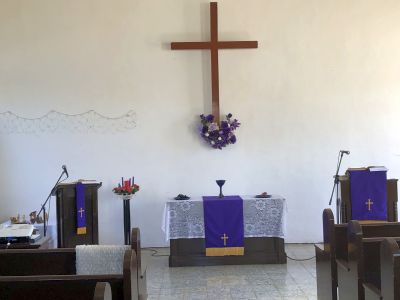
Returning to Havana there were some options offered. Some took a driving tour in some old classic cars and three of us decided to attend the Sunday religious service with the International Christian community. The liturgy was in English. Some used cordless earphones where the words were simultaneously translated into Spanish. The liturgy was familiar to all Christians, with scripture reading, sermon, offering, Eucharistic prayer, and communion. The prayer and music leader was black Methodist woman from Jamaica. The pastor who gave the homily frequented his words with “Alleluia”. As we lined the aisles for the communion service we saw Asians, whites, Cubans of all colors, adults, and children waiting to receive the “Body and Blood of Christ.” After the liturgy, we had a chance to meet some of the people. One man was a pastor in a small Church where he had Sunday morning liturgy and then came to the International community at 5 pm. A Presbyterian deacon walked us back to our residence giving a walking tour of the neighborhood. He told us how moved he was by the words of Pope John Paul when he visited Cuba. He said he was moved to tears by his words and later was impressed when Pope Benedict at a visit gave the same message. He was one of the co-founders, with our guide, of the International Christian Community. He said he had been blessed to travel the United States. As we were returning he pointed out the Friendship House wherein the side yard a rock n roll band was performing in English.
Monday, Dec.4th
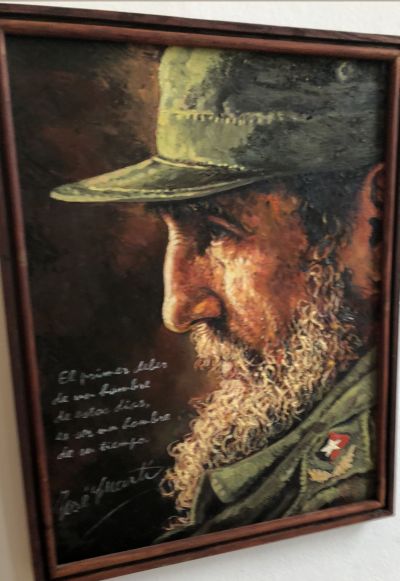
In the morning we went to the campus Pisco-Pedagogical Center “La Castellana”. It is a school for children with disabilities from age 5 to age 18. In the meeting room where we were waiting for the tour by the staff, there was a wall poster of Fidel Castro’s quote about what Revolution is. Our guide had it translated for us and told us she has it up in her office at home as a source of inspiration. It read:
“Revolution means to have a sense of history; it is changing everything that must be changed; it is full equality and freedom; it is being treated and treating others like human beings; it is achieving emancipation by ourselves and through our own efforts; it is challenging powerful dominant forces from within and without the social and national milieu; it is defending the values in which we believe at the cost of any sacrifice; it is modesty, selflessness, altruism, solidarity and heroism; it is fighting with courage, intelligence and realism; it is never lying or violating ethical principles; it is a profound conviction that there is no power in the world that can crush the power of truth and ideas. Revolution means unity; it is independence, it is fighting for our dreams of justice for Cuba and for the world, which is the foundation of our patriotism, our socialism and our internationalism.”
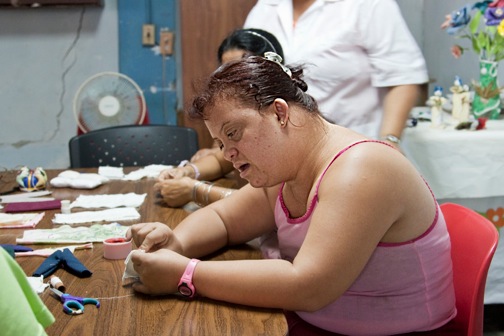
This quote says a lot about the Cuban people and their sense of sharing for all with human dignity as expressed in this school. The classrooms were small with about four or five children with a teacher and a full-time aide. Some of the children were making beautiful flowers from recycled materials. They were proud of their work and willing to share with us. The goal of this place is to prepare the children to be integrated into society. The children from a distance went home each weekend and some from the local community went home daily. Hopefully, at age eighteen they could leave, but if not, they were welcomed to stay. One young man, a longtime resident, accompanied the Doctor and staff who were showing us around. He was the informal official greeter for the place. Near the end of the tour of the grounds three students performed for us in an outdoor theater area. One young boy sang for us and two girls performed dances for us. It was obvious that they had practiced long hours to master these dances.
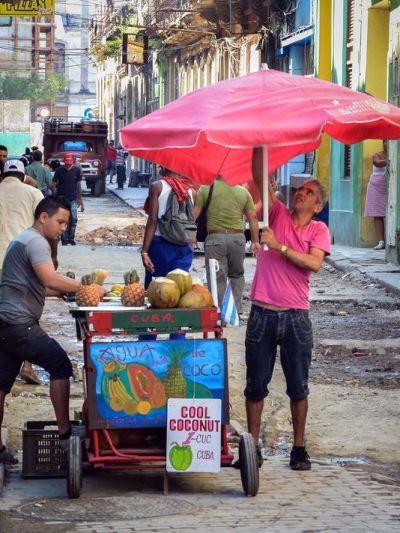
After lunch at the Council of Churches, we met with a Cuban economist. She explained in an easy to understand language how the Cuban economy works, what they imported and exported. The United States boycott of Cuba is still a major block for Cuba to growth and prosperity. Even other nations who do not boycott Cuba have to be careful about importing Cuban products. The US used its influence to block too much trade with other countries. “If you want to be friends of USA and doing business with us you need to limit your trade with Cuba. You can trade with us or Cuba.” Despite the many obstacles the Cuba economy was doing okay. One of the losses and benefits of USA embargo is that Cuba has difficulty obtaining loans from the international community. However, as a result, Cuba, unlike many developing countries, is not drowning in debt. With the 700 billion US Defense budget on my mind, I asked about military spending. I discovered that for the most part, the military is self-financed. The military runs hotels, bus lines and other profitable enterprises. It also helps that it is not at war all over the world as the US is. Our US leader told us of pages and pages of business that we were not allowed to do business with since they had a military connection. Cuba is a leader in developing nations of how to thrive and be independent of big countries like China, Russia or USA.
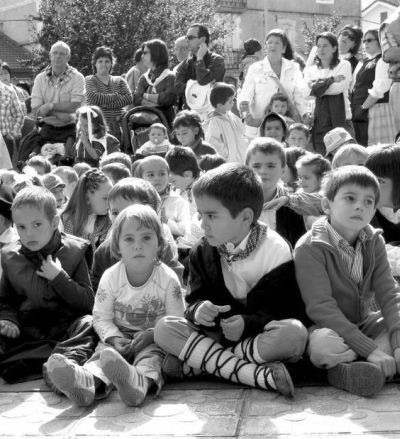
Children of Operation
Peter Pan
Next, we met with a staff member of the Religious Affairs Office of the Cuban Communist Party. Considering we were going into the headquarters of Communist Party security was minimal. The staff member, one of five, was a most gracious host. While she was talking staff members were serving us drinks and snacks. She explained the history of the Revolution and the Churches. At first, there was some tension since the Catholic Church had close ties with the former oppressive government that was overthrown. She mentioned as did an early speaker at the Council of Churches Operation, the Peter Pan Project, the Catholic Church and the US State Department were involved in Operation Pedro Pan, a program that ran from 1960 to 1962 airlifted more than 14,000 unaccompanied Cuban children to the U.S. The Church and CIA convinced parents that children would be taken away from the families and indoctrinated with Communism. I remember hearing about this in High School, how children were being separated from families in Cuba. Of course, this was not true, just propaganda. However, Operation Petro Pan left a sour relationship with the people and government of Cuba.
She pointed out how freedom of religion was guaranteed and encouraged in Cuba. Christian churches have flourished in modern Cuba and enjoy good relations with the government. The speaker took questions and it was clear that she had a deep respect for all religions.
It should be noted that the Communist party is the only political party in Cuba but membership in the party is not required for membership in the government. Our translator told us how she was a proud member of the Communist party since she was 14, however, she respected all religions and Churches. The role of the party, according to her, was to advise and guide the government to keep the spirit of the revolution alive and thriving.
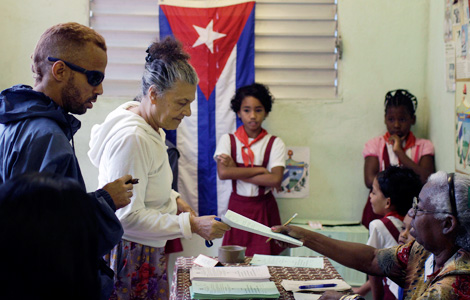
During the trip, we discovered that Cuba is governed by an electoral system built from the ground up. Over 95% of Cubans vote each election. Simply stated, each neighborhood, 1000 to2000 residents, has an elected council to govern that area. From this council members are elected to regional governing bodies. From these regional governing bodies representatives are elected to each State or province government. Along with representatives from groups like unions and Women Federation members of the Parliment are elected. The Parliment of Cuba is the highest governing body in the country. At all levels, elected officials are not paid but serve the common good of all.
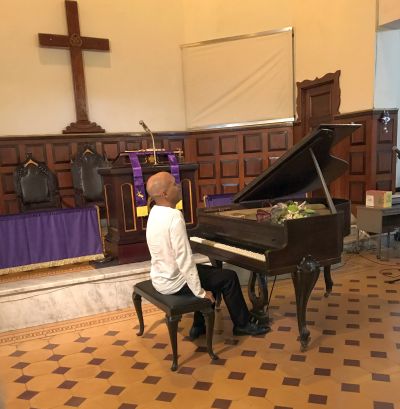
That evening we were treated to a recital by a professional concert pianist Fran Paredes. He delighted us with a concert of classical musings. His world-class skill was obvious and breathtaking. After the concert, we had dinner at the Presbyterian Church where the concert took place.
After dinner, there was a presentation about gender and civil rights. Again we were reminded that every Cuban citizen had the right to basic food, shelter, healthcare, affordable housing and education. Cuba has made a conscious effort to treat all persons with equality, despite race, gender and religion. Women’s rights were particularly promoted after the Revolution and presently women are well represented in all professions and at all levels of government. 53.2 percent of Cuba’s Parliment are women, which places the island in the second Parliament on the planet with the greatest female participation. It reminded me how a country that admits inequality and racism can do something positive to eliminate it and all segregation.
Tuesday, Dec. 5th
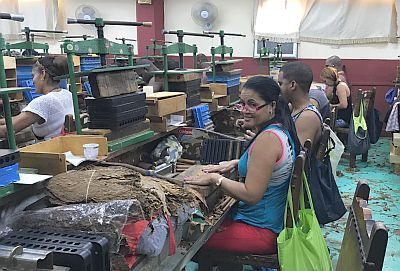
In the morning we visited a tobacco factory in Havana. Cuba is blessed with all the right conditions to grow the finest tobacco. Cuban cigars are considered the finest in the world. Tobacco grown in Cuba is dried at the farms for a long time. Our guide gave us a tour of the factory where each cigar is hand rolled. He said it took years to be a good cigar roller and gave us a demonstration of the process. Workers are rewarded for good work by either getting time off when their quota is finished for the day or getting extra pay to stay on. One extra benefit, each worker gets a monthly allotment of cigars which they can either sell or smoke.
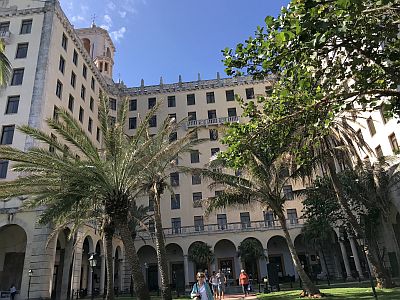
I believe it was this day that we visited the International Hotel, a former hot spot for the rich and famous and the mob from the USA. It is a beautiful hotel right on the oceanfront. Now everyone can visit the grounds and it is a premium tourist hotel. We walked through the hotel admiring the ornate decorations inside and outside at the well-groomed gardens. Pat’s mother was there when her uncle was the owner of the Boston and Milwaukee Braves. She purchased a wood cigar holder outside at the gift shop to hold the two Cuba cigars she had purchased for her older brother. With others, we had coffee and other drinks on the outside terrace. Our local guides told us the hotel rates are now about $200 a night, high by Cuban standards but low for luxury hotels in the USA.
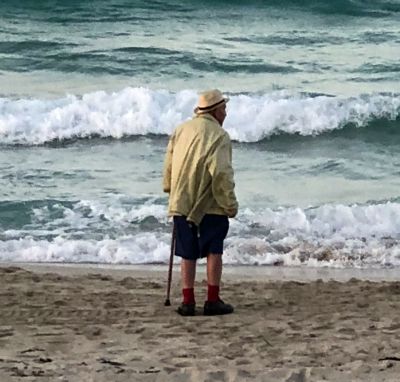
After a tremendous lunch at the El Figaro restaurant, we headed for the provincial state of Matanzas. After some van touring we settled into our second place to stay, Casa del Carino, House of Caring or Love, in Varadero. It was a big old house right across from a beautiful long beach. The owner had given it to the community, particularly the Preberytiarn church nearby that was the home of our Cuban guide. The community had rehabbed the house and during the summer months made it into a camp for disabled children. Our room, like the others, had six beds in it with a rollaway bed in the closet. At no cost, the children can enjoy the beach and the lively tourist area. During the winter months, the house had retreat groups, like us, to support their ministry. This year, due to the hurricane, it had been tough on the volunteers since only three other groups, besides the two Gate groups had used the house. We had the first of our many wonderful fresh and home-cooked meals. One of the volunteers was a woman who was the daughter of our main guide and the wife of our smiling driver.
Wednesday, Dec. 6th
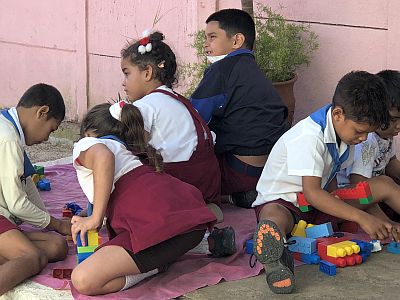
After Breakfast in the morning, we traveled to a local school for children with cognitive disabilities. 70 local children from pre-school thru high school were there during the school day. With 12 teachers, 7 aides, special teachers for language and other skills, therapist, psychologist and other staff the ratio of children to staff, was about two to one. We took a tour of the grounds including a well-kept garden where high school students were working. After the tour, some children came out of classrooms for recreation. One group of very young children were playing with Lego trains in a box area. I joined them, first just being present and later as a participant. Someone came over and told me that they were taking a group picture with the staff. I just begged off and kept being with the children till we were loading the van to go. This school was another good example that if you treat all people, especially these special children, with dignity and respect they will respond.
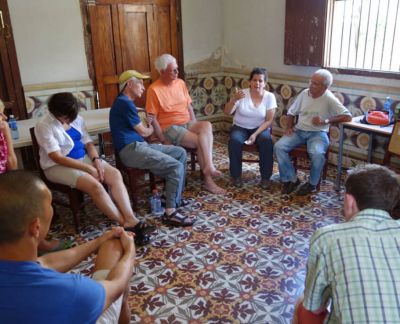
Next was a visit to a Senior Day Care Center. Someone observed later in the trip there were no nursing homes or assisted living centers as far as we could see in Cuba. In part due to the excellent health system, Cuba has one of the highest life expectancies in the world. Seniors were part of the extended family in a household. However, for some, when other adults were at work and children at school a Senior Daycare was necessary. At the center, seniors had lunch and an early dinner. They engaged in many activities, including music, exercise and crafts. We sat in one big circle in an open building while some of the seniors told us stories about life in Cuba and themselves. Some were very old but clear minded. They are a good testimony to the excellent health system in Cuba. They seemed very happy and content.
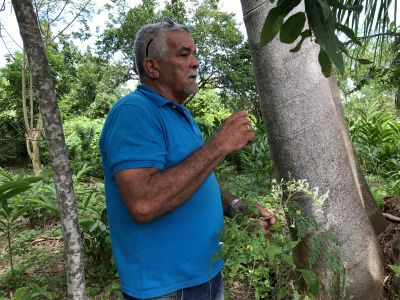
Omar with moringa tree
Next was a visit to Omar Gonzales’s self-sustainable farm. He was a gracious man who told us the story of the organic farm and how it has grown and produced so many flowers, vegetables and fruits. One of the trees he introduced to Cuba was the Moringa tree, a superfood offering enormous amounts of nutrients, antioxidants, vitamins, and minerals that our bodies need. Its flowers and leaves have many uses. When showing us the trees he gave us some branches that were flowering. For the rest of our time at Casa del Carino we enjoyed Moringa tea.
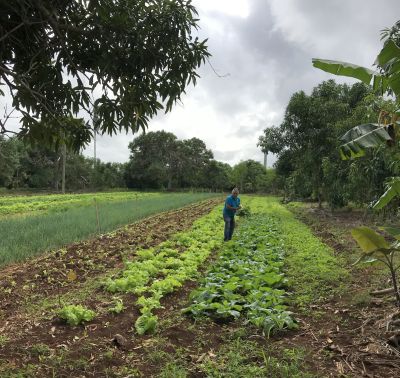
One story he told was how after word of the Moringa tree came out he received a call from Fidel Castro on his cell phone. Castro wanted to know all about this tree and its benefits and the conversation went on and on. Fidel was a good talker and at one point Omar’s cell phone battery was low and Omar had to tell Fidel to call him back on his landline. He said the conversation went on for about 5 hours and was the beginning of a friendship between Fidel and himself about his sustainable farming. Fidel made many visits to the farm and invited Omar to talk at events about his farming.
Omar showed us all around including the various systems, like a homemade irrigation system, he and his workers had developed. Our GATE leader knew from our trip to Venezuela that I had used worms to make the rich soil in my garden so asked me to do the thank you. Afterward, I made mention that I would like to see his worm farm. He was only too happy to show us a long box of rows where worms were feeding and casting their healthy poop. Like many of us, he had a system of removing worms and harvesting the wonderful black, casting enriched soil.
That afternoon we had some free time. Being right across from the beach Pat and I got on our swimming suits and headed to the sandy beaches. The sun was shiny and for some locals the water was cold. But not for us. The water was warm and we spent time frolicking in the large waves coming ashore.
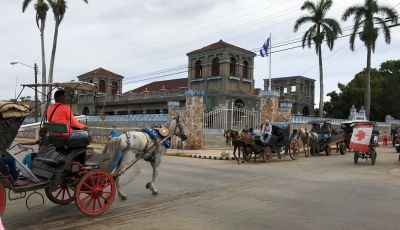
Afterward, we took a stroll through the main street of this tourist town where there were many craft artists lining the streets. From the van, I had seen a sandal place. I have been looking for sandals to replace the broken ones I had left home. There, on December 6th I found a beautiful pair of leather sandals. We did not like negotiating the process but Pat was able to get about two Cuc’s ($2.30) off the price which was already reasonable.
After dinner, our Cuban guide told us the story of Casa del Carino and how it was truly a caring place. Her own story was fascinating. She was a teenager during the revolution and in her second marriage had married a Presbyterian minister who was well known for his caring ways and also a member of parliament. He had died but she continued his work and legacy. I found out later that she was now nominated for the parliament.
Thursday, Sept. 7th
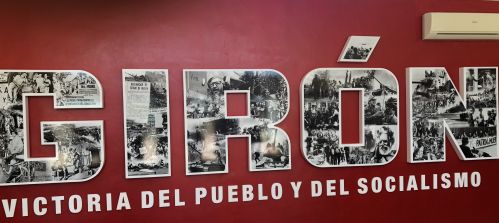
After Breakfast the next day we headed out to the Zapata peninsula and museum Playa Giron (Bay of Pigs). This US invasion, ordered by President Kennedy and under the guidance of our CIA was a pivotal event in the history of Cuba. The invasion force of about 1500 Cuban exiles was in about 72 hours, beaten back and surrendered. What I did not know was how right after the Cuban revolution the USA started terrorist attacks on Cuba, bombings, use of infectious viruses, propaganda and assassinations. Days before the invasion US aircraft had been bombing Cuba airfields and other facilities. The Cuban people rallied and before millions, Fidel Castro gave his famous speech which included the rallying cry of “Homeland or Death.”
At the beginning of the tour, we saw on a TV set a film of the great victory that was made right after the invasion. It showed how this tiny nation resisted the armies of the imperialist empire of USA. It was like one of those films you would see during World War II in the theater. The museum was on a more somber note, greatly honoring the fallen Cubans. Most of the captured US Cuban exiles were traded back to the USA for some food and medical supplies.
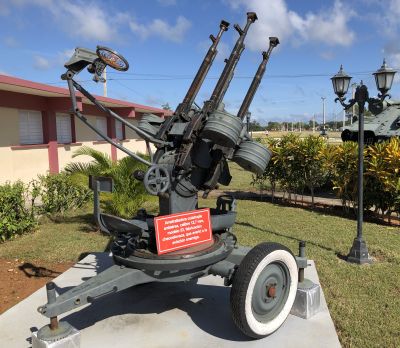
In and around the museum were weapons of the war, tanks, guns and other vehicles. This was truly a pivotal moment in Cuba history. Cuba is honored around the world as the first country of Latin and South America to be free of US dominance. It has paid and is paying the price for its independence.
On the way back from the Bay of Pigs we stopped for lunch at a delightful country restaurant off the main road.
Friday, Dec. 8
The next day we went to the city of Cardenas to visit the Neuro-Development Center. It is a healing center where children with various neurological disorders come for treatment. All the treatment is low tech, one on one treatment for children with parent and therapist. The two doctors that showed us around had both served as Cuban doctors in other developing countries. Parents and children wait in the outer room for treatment, sometimes daily. Each child is assessed and a treatment program is designed for each one. When we asked about the lack of technology the Doctor responded that they wished had more but they made the best use of the greatest technology of all, the human brain. He was proud of past children who now as adults are integrated successfully into society. He told us of one girl who had suffered severe brain injury and, with help of the clinic, had won gold in the Special Olympics.
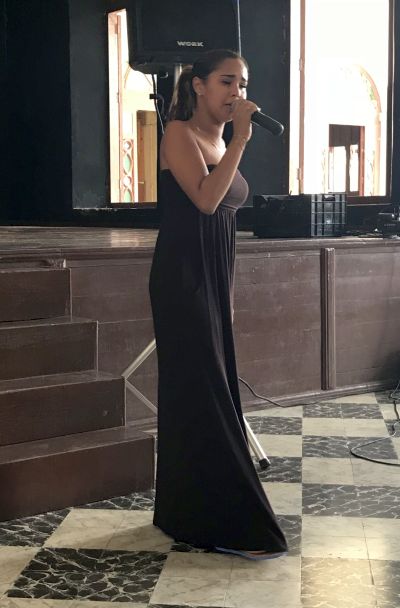
Our next scheduled visit to the Home for Children without family care had to be canceled. Fortunately, our Cuban guide was able to contact the local cultural center. After a brief visit to their cultural arts theater and art museum, we returned to the main cultural center for a performance of two professional singers, a young woman who had been trained in Music at the center and her mentor. With beautiful voices, they performed a number of songs, solo and in duet, some familiar to us like a song from West Side Story and some deeply rooted in Cuban society. It was an outstanding performance and although the lyrics were in Spanish you could naturally relate to the music spiritually and emotionally.
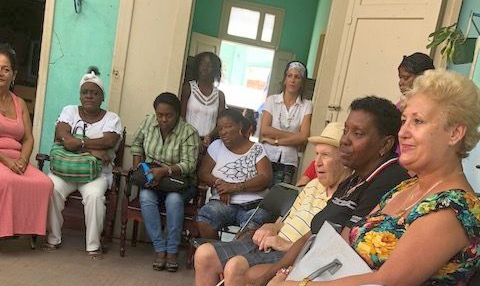
Next, we met with the local Women’s Federation. The women’s federations are an important part of the cultural fabric of Cuban Society. Women rights are a major focus in Cuba as is racial equality. Cubans are aware of past discrimination and go out of the way to promote equality. Women leaders from the various neighborhoods gathered in a circle to speak with us. There was a woman who looked of Spanish heritage with blond hair who represented one neighborhood. There was another woman with very African features who was the chosen representative for nine neighborhoods. They were all gracious women who were proud of their Cuban heritage and revolutionary spirit. They spoke of their work on all levels of society for women rights.
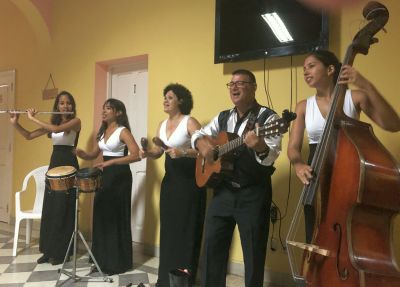
That evening, after dinner at “Casa del Carino” we were treated to a music quintet, Armonia, playing traditional and popular Cuban music. Once again we were reminded of how important music is to the Cuban culture. They were delightful.
Saturday, Dec. 9th
This was our one rainy day. In the morning we met with the director of tourism in Varadero. Tourists from all over the world, except the US, come to Cuba to enjoy the culture, beaches, shops, hotels and other attractions of this part of the island. He explained to us how tourism had become a big part of the economy of Cuba and how the people had welcomed tourist. We took a tour of the island with our guild pointing out the major hotels for people from all over the world. We stopped at one place where they had stores along the oceanfront that mostly catered to Canadians. This part of Cuba reminded me of our visits to Hawaii with all the resorts along the ocean, beautiful scenery, flora and rolling hills of green leading to beaches. However, Cuban tourism is a lot less expensive than Hawaiian. We also stopped at a former mansion of the DuPont family of Delaware that now was turned into a dining area with a certain amount of tourism rooms. It was next to an 18 hole golf course.
Later in the day, we went to our main Cuban guide’s house in a Preystarian church rectory.
Sunday Dec. 10th
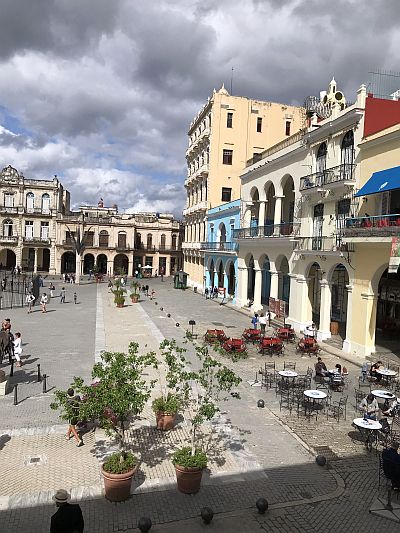
balcony overlooking
square
After breakfast, we departed to Havana. In Havana, we were taken to a central area of museums, Cuban Art Museum, Revolution museum and others. Pat and I first went to the Revolution Museum. There step by step we were taken through the history of Cuba Revolution. The museum was in a building that once was the seat of the Cuban government under Baptiste, the final ruler of Cuba under American influence. We learned more about the Cuban heroes like Che Guevara and Fidel Castro. We saw exhibits of how the USA had fought so hard to undermine the revolution, the terrorist attacks, bombings, assassination attempts and successes and the releases of deadly viruses to harm the Cuban people. For example, the CIA had released the swine flu virus in Cuba killing over a million pigs, the main meat source for Cubans. With all that the US has done or is doing to defeat the Cuban revolution, it is surprising the people are not bitter or cynical to the USA. On the way out of the museum, there are comic busts of Battista, George Bush Sr. and Jr. and Ronald Regan. Under each statue is a statement thanking them for their opposition to Cuba that just made it stronger.
The Cuban Art Museum was large. Cuban Art traces itself back to the indigenous people who were eliminated by Spanish conquistadors and reflects the culture. Lunch was the one meal on our own. We went to one of the squares in Old Havana. On a balcony overlooking the square, Pat and I found a restaurant with authentic Cubano sandwiches. They were delicious.
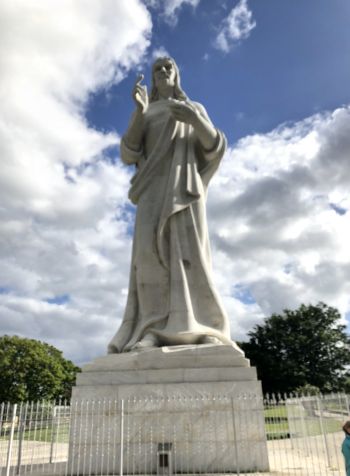
Jesus overlooking
harbor of Havana
Conclusion
During my travel to Cuba and coming home I was reminded of Jesus’ parable, Judgment of Nations, in the Gospel of Matthew (25:31-) Jesus separates the nations before him into two, some on right and some on left. To the people of the nations on his right, he welcomes them into the Kingdom of God. He says they gave food and drink to him when he was hungry and thirsty, clothed him when he was naked, welcomed him as a stranger, cared for him when was ill and in prison. When people of these nations asked him when they did all these things he says: “Whatever you did for the least of my brothers and sisters, you did for me.” To the people from nations on the left he says: “Depart from me, you accursed, into the eternal fire prepared for the devil and his angels.” When they ask him why he will say that when he was hungry, thirsty, naked, ill, and in prison, they did not care for him. When they asked him when they did not minister to him he says: “What you did not do one of these least ones you did not do for me.” If the judgment of nations parable was today I believe Cuba would be on the right welcomed into eternal life and the US would be on the left, condemned.
Yes, Dorothy Day, the promise and hope you saw in the Cuban revolution have come true. May God continue to bless the people of Cuba.